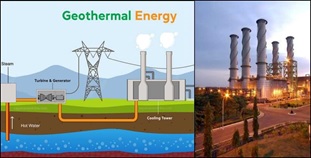22 September, 2025
First National Policy on Geothermal Energy
Fri 19 Sep, 2025
Context:
- The Ministry of New and Renewable Energy (MNRE) notified the first-ever National Policy on Geothermal Energy (2025).
Background:
- Geothermal energy development in India has been relatively limited, but it holds immense potential.
- The Geological Survey of India (GSI) has identified 381 hot springs and around 10 potential geothermal provinces.
- These provinces are spread across 16 states and UTs including Ladakh, Himachal Pradesh, Gujarat, Uttarakhand, Jharkhand, Chhattisgarh, Odisha, Bihar, Haryana, and Jammu & Kashmir.
- India’s estimated geothermal energy potential is 10,000 MW (10 GW), while the present installed capacity is negligible.
- Globally, geothermal installed capacity was 15.4 GW (2024), with the USA, Indonesia, and the Philippines leading.
- MNRE constituted a Task Force in 2024, comprising research institutes and industry representatives, whose recommendations formed the basis of this policy.
Objectives:
- Exploration and commercialization of high-quality and sustainable geothermal resources.
- Promote both electricity generation and direct uses (district heating, agriculture, aquaculture, building heating/cooling).
- Integrate geothermal energy into the renewable energy mix for India’s Net-Zero 2070 goal.
- Encourage indigenous technology development, innovation, and adoption of global best practices.
- Facilitate collaboration with public, private, and international institutions.
- Promote mineral extraction opportunities (e.g., silica, lithium) for economic growth.
Key Provisions:
- Nodal Agency: MNRE designated as the nodal body for regulation and coordination.
- Exploration & Permits: Single-window clearance, state-level guidelines, community consultations (esp. tribal areas).
- Technology & Innovation: Focus on high & medium enthalpy resources; promotion of Enhanced Geothermal Systems (EGS) and Ground Source Heat Pumps (GSHPs).
- Financial Incentives: Viability gap funding, tax exemptions, customs duty relief, land allocation, 100% FDI allowed.
- Capacity Building: Establishment of Centres of Excellence (CoEs), training, R&D; approval of 5 pilot projects.
- Monitoring: Regular reporting and impact assessments.
Benefits and Potential Impacts:
- Environmental: Reduction in GHG emissions, decreased dependence on fossil fuels, 24×7 power availability.
- Economic: Job creation (exploration, drilling, technology), revenue from mineral extraction.
- Energy Security: Stable and reliable renewable source.
- Social: Rural and remote area development; over 50% efficiency in HVAC systems.
Challenges & Suggested Solutions :
- Technical: High upfront investment, risky exploration → Technology transfer through international collaborations.
- Regulatory: Approval delays → Fast-tracking via digital single-window platforms.
- Financial: Low private investment → Risk-sharing via insurance & green funds.
- Social Resistance: Protests by tribal/local communities → Benefit-sharing models for balance.
Geothermal Energy
Definition:
- Geothermal energy is the energy derived from heat stored beneath the Earth’s surface. It naturally emerges through hot springs, geysers, volcanic regions, and subsurface rocks.
Key Features:
- Clean energy – very low carbon emissions.
- Renewable – Earth’s heat is continuously replenished.
- 24×7 Availability – not weather-dependent like solar/wind.
- Multi-purpose Use – power generation, district heating, agriculture (greenhouses), aquaculture, industry, desalination, and tourism.
Global Scenario:
- Leading Producers – USA, Indonesia, Philippines, Turkey, New Zealand, Iceland, Mexico, Kenya.
- Iceland – meets ~90% of its energy needs from geothermal + hydropower.
- USA – world leader in geothermal electricity production.
Geothermal Energy in India
Potential Capacity: ~10,000 MW
Major Regions:
- J&K & Ladakh (Puga, Chumathang)
- Himachal Pradesh (Manikaran, Tapovan)
- Uttarakhand
- Chhattisgarh (Tattapani)
- Maharashtra & Gujarat (Kutch region)
- Andaman & Nicobar Islands
Benefits:
- Reduces GHG emissions.
- Ensures energy security in rural/hilly areas.
- Cuts dependence on imported fuels.
- Promotes employment and tourism.
India’s Geothermal Energy Landscape
Geothermal Atlas (2022):
- Geological Survey of India (GSI) published a geothermal atlas.
- Identified 381 thermally anomalous areas across the country.
Estimated Potential: ~10,600 MW across diverse geological regions such as:
- Himalayas
- Gujarat
- Maharashtra
- Son-Narmada-Tapti (SONATA) Basin
- Godavari Basin
- Northeastern states
Major Geothermal Reservoirs
Puga–Chumathang (Ladakh):
- Temperature up to 240°C.
- Suitable for flash/binary power plants.
- India’s first and world’s highest geothermal power project being developed here by ONGC at >14,000 feet altitude.
Tattapani–Surajkund Belt (Chhattisgarh/Jharkhand):
- Medium enthalpy resources with 110–150°C temperature.
Cambay Basin (Gujarat):
- Medium to high enthalpy capacity.
- Suitable for both electricity and direct-use applications.


















